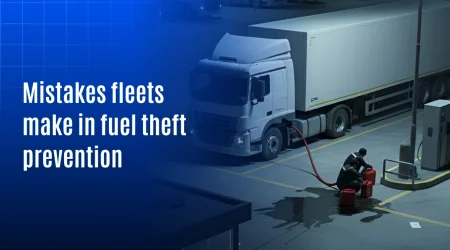What’s the Best Way to Manage Construction Fleet Vehicles Efficiently in Thailand?

Manage Construction Fleet Vehicles Efficiently in Thailand
As Thailand’s construction industry grows, there is a greater need for new solutions to manage complex projects effectively. The construction sector is currently valued at over USD 42 billion. This plays a crucial role in infrastructure development across the country. However, with this growth comes the challenge of maintaining visibility over a fleet of vehicles and machinery whose condition or level of activity isn’t always clear. Construction fleet vehicles aiming to optimize resources, reduce costs, and improve project timelines need to take a step ahead. Implementing advanced vehicle monitoring systems can make a significant difference.
This blog explores how construction managers in Thailand can leverage work hour tracking, asset usage monitoring, and fuel management. This ensures managing efficient fleet operations and minimizing resource wastage.
The Need for Precise Tracking of Fleet Construction Vehicles
Construction projects require a wide range of vehicles and heavy machinery, many of which are semi-static, rarely moved, or dedicated to specific tasks. For instance, equipment like cranes or cement mixers often remains stationary for long durations, only used intermittently. Without a reliable way to track their exact operating hours, these assets may accumulate excessive idle time, leading to increased costs and reduced efficiency.
Optimizing Work Hours and Asset Utilization
By implementing a system that accurately records work hours, managers gain clear visibility into the usage patterns of each vehicle. This data helps in determining if equipment is being underutilized or overused, supporting more effective deployment across the project site. For example, equipment that remains idle can be reallocated to areas where it’s needed more, enhancing productivity and reducing unnecessary wear and tear.
Tracking work hours also assists in planning preventive maintenance, and ensuring machinery remains in optimal condition, which is essential for minimizing downtime and extending asset lifespan.

Advanced Monitoring Solutions for Secure and Efficient Construction Operations
On construction sites, a wide range of vehicles and machinery are in use—from massive cranes and loaders to specialized equipment like excavators and concrete mixers. With such a diverse fleet, keeping track of each asset’s location and ensuring it remains within designated boundaries becomes crucial. Implementing advanced monitoring solutions can simplify this task, leveraging devices like beacons, tilt sensors, and fuel sensors, among others.
These technologies work together to enhance operational oversight. For instance, beacons provide precise location data, ensuring assets stay within their assigned areas, which is especially valuable on expansive and crowded sites. This helps prevent unauthorized movement and reduces the risk of asset misplacement or theft. Tilt sensors, meanwhile, monitor the angles of machinery, offering an additional layer of safety by detecting unsafe tilts that could lead to accidents. These insights, combined with work hour and fuel tracking, support both efficient resource management and enhanced safety compliance on construction sites.
Ensuring Safe Operation with Tilt Sensors
Tilt sensors, on the other hand, monitor the orientation of heavy equipment to ensure it remains within safe operating angles. This is especially beneficial for machinery that handles loads at heights, like cranes or forklifts, where even slight tilts can increase the risk of accidents. Real-time alerts for unsafe tilt angles allow for immediate corrective actions, keeping both equipment and personnel safe.
By combining beacons and tilt sensors with work hour tracking, construction companies in Thailand can foster safer work environments and avoid the costly disruptions that accidents or unauthorized equipment use can cause.
Reducing Operational Costs through Fuel Monitoring
Fuel expenses form a significant part of any construction budget. Even minor inefficiencies can accumulate into substantial costs over time. A comprehensive fuel monitoring system helps tackle this issue. By providing insights into fuel consumption patterns, it provides an ease to detect and prevent wastage.
Detecting and Preventing Fuel Theft
Theft or mismanagement of fuel is an issue many construction sites face. Fuel monitoring allows managers to track usage patterns and receive alerts. When there are sudden drops in fuel levels, indicating potential theft or leaks. This transparency in fuel consumption not only prevents wastage but also promotes accountability among operators. Moreover, it helps operators to control overall project costs.
With rising operational costs, fuel monitoring offers a practical way for construction managers to cut expenses without compromising productivity.
Benefits of Integrated Monitoring Solutions for Thailand’s Construction Sector
By adopting an integrated approach to vehicle and asset monitoring, construction companies in Thailand can achieve several key benefits:
Improve Productivity
Data-driven insights into equipment usage allow managers to deploy resources more effectively, reducing idle time and increasing project efficiency.
Improved Safety Compliance
From features like monitoring the asset activity through tilt sensors, the SOS feature along with location-based tracking fosters a safer work environment, ensuring that machinery operates within set parameters and adheres to safety guidelines.
Cost Savings and Optimized Resource Use
Accurate work hour tracking and fuel monitoring minimize resources to be wasted. It allows companies to save on fuel and maintenance costs while improving overall profitability.
Better Maintenance Planning
With work-hour data, managers can plan maintenance activities based on actual usage, reducing unexpected breakdowns and prolonging equipment lifespan.
As the construction industry in Thailand advances, the integration of these technologies offers a strategic advantage. Moreover, it supports sustainable growth and efficient project completion. By leveraging monitoring solutions that provide real-time data and actionable insights, companies can build a competitive edge, ensuring that their resources are used wisely and projects remain on schedule and within budget.
In an industry where delays and wastage can heavily impact profitability, the ability to track, analyze, and optimize operations through smart technology proves invaluable. Construction managers who invest in these solutions can look forward to streamlined workflows. It helps in creating safer work environments. Additionally, it is said to be a more sustainable approach to resource management. Eventually benefiting by setting new standards for excellence in Thailand’s construction sector.





